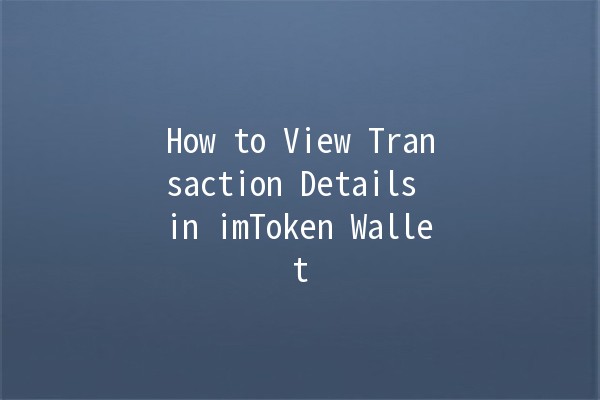Managing your cryptocurrency transactions can sometimes feel like navigating a complex maze, especially if you're not familiar with how to access and interpret your transaction details. The imToken wallet, one of the most popular digital wallets, offers a userfriendly interface that simplifies this process. In this article, we will explore various methods to view your transaction details in the imToken wallet, and we will provide you with productivity tips that can enhance your experience with this digital wallet. Let’s delve into the essential steps you can take to effectively monitor your transactions and ensure a seamless experience managing your crypto assets.
Before diving into transaction details, it’s important to familiarize yourself with the main features of the imToken wallet. The app is designed to be intuitive, ensuring that users can easily manage their digital assets. Here are some key components of the wallet's interface:
Home Screen: This is where you can view your overall balance and the various tokens you hold in your wallet.
Assets Section: By tapping on this section, you can see detailed information about each token, including current prices and trends.
Transaction History: This section logs all the transactions associated with your wallet, including incoming and outgoing transfers.
By becoming acquainted with these areas, you will make it easier to locate transaction details when needed.

To view your transaction details in imToken, follow these steps:
Tap on the “Transactions” option from the main menu.
This will take you to a comprehensive list of all transactions associated with your wallet.
Scroll through the list to find the transaction you're interested in.
Click on the specific transaction to open its details.
Once you open the transaction details, you will see information such as the transaction hash, status, amount, date, and any fees involved.
This screen may also display relevant links to block explorers if you wish to see further details.
On the transaction details screen, here’s what you might typically see:
Transaction Hash: A unique identifier for your transaction.
Timestamp: The date and time the transaction took place.
Status: Whether the transaction is pending, confirmed, or failed.
From/To Addresses: Wallet addresses involved in the transaction.
Amount: The quantity of cryptocurrency that was sent or received.
Gas Fees: Costs incurred for processing the transaction on the blockchain.
One productive way to keep track of your transactions is to make use of tags. By labeling your transactions, you can categorize them based on different criteria, such as personal expenses, investments, or transfers to friends and family. This helps in effectively managing your finances and makes it easier to find specific transactions later.
If you send a certain amount of Ether to a friend for dinner, use a tag like “Dinner with John.” This will make it easier to pull up and reference when needed.
Make it a habit to review your transaction history on a monthly basis. This practice not only helps you keep tabs on your spending but can also alert you to any unauthorized transactions. Many users often overlook the importance of regularly monitoring their wallets, leading to potential losses.
Set a calendar reminder at the end of each month to review your transactions. Crosscheck any large transactions with your personal records to ensure accuracy.
While imToken provides a straightforward way to view transactions, external block explorers can offer even more indepth information. For instance, sites like Etherscan allow you to search transaction hashes and view block confirmations, historical data, and other wallet interactions.
If you see a pending transaction in your wallet, you can quickly search for the transaction hash on Etherscan for uptotheminute information regarding its status.
Understanding gas fees can greatly enhance your transaction timing. During periods of high demand, gas fees can spike, causing your transactions to take longer or become more expensive. By monitoring gas fees, you can choose optimal times for executing transactions.
Use gas trackers like EthGasStation to find the current average gas fee. By timing your transactions when fees are low, you can save money.
Most wallets, including imToken, provide the option to enable notifications for transactions whether incoming or outgoing. Setting up these alerts can help you stay informed about any monetary movements in realtime.
Enable notifications to alert you when a significant transaction occurs, or if gas fees exceed a predetermined limit.
If your transaction is missing, ensure that you are searching the correct wallet and time frame. It may also take some time for the transaction to appear if it is still pending or being processed. If the issue persists, check the transaction status using a block explorer.
To enhance your transaction speed, consider adjusting your gas fees. Higher gas prices typically lead to quicker confirmations. Always balance speed and cost to suit your needs.
Yes, sharing your transaction hash is generally safe as it only provides information about a specific transaction. However, avoid sharing sensitive personal information or wallet addresses publicly to maintain privacy.
Yes! imToken supports multiple tokens and currencies. You can switch between currencies in your wallet to view their respective transaction histories.
If you suspect fraudulent activity in your wallet, immediately change your wallet password and enable twofactor authentication. Review your transaction history for unknown transfers and consider contacting imToken support for further assistance.
Currently, imToken does not offer a builtin feature for exporting transaction history. However, you can manually copy your transaction details or take screenshots for your records.
Navigating your transaction history in the imToken wallet is straightforward once you understand where to look and how to use the available features. By employing various productivityenhancing tips, you can manage your digital assets more effectively and stay informed about your transactions. Remember, regular monitoring, leveraging external tools, and enabling notifications can significantly enhance your experience with cryptocurrency management.
Stay vigilant and proactive in managing your wallet, and you'll find that keeping track of your transactions becomes second nature! Happy transacting!